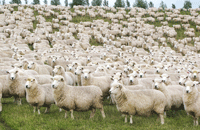Pasture management could boost sheep grass use

Adopting the dairy way of thinking when it comes to managing pasture will allow UK sheep farmers to use grass more efficiently. Debbie James reports.
Fat lambs finished on grass should be moved to fresh pasture after they have grazed just 50% of covers to capitalise on the best quality intakes.
Farmer’s son Eurion Thomas, who has studied how Kiwi lamb producers maximise grass use, says sheep farmers in New Zealand reserve the best pasture for weaned lambs up to the point of finishing.
They get preferential grazing, particularly when grass quality is diminishing, and never stay in a field long enough to graze it out. Stocking rates are kept low too, says Mr Thomas.
“These lambs will graze 50% of a field and are then moved on. Ewes will be turned into that field to graze out the old material. This is the best way of topping and it ensures quality regrowth,” he says.
Forage use on sheep systems in New Zealand is 67%, compared to 50% in the UK. The major difference is that most Kiwi sheep farmers measure and rotationally graze their pastures. Every effort is made to prolong the growing season; some reckon they can get up to three weeks extra growth at each end of the season solely by better management. “If they can get this additional four to six weeks of growth it is invaluable to the farmers, as it can shorten winters by between 23% and 35%,” says Mr Thomas.
To achieve an efficient forage system, careful planning and budgeting is essential. Some Kiwi sheep farmers use rising plate meters to determine pasture covers by measuring compressed sward height, but most employ a visual assessment of grass covers to determine feed budgets. Budgeting means they only feed what they need to and know in good time when there is going to be a shortfall. Their aim is to maintain grass covers of about 4-6cm. When grass yield exceeds these targets, quality will reduce, and it will be more difficult for stock to graze it cleanly.
“To manage pastures properly, they need to be monitored – the majority of sheep farmers I met thought in kg/DM/ha. Even when the assessment was visual it was backed up by years of training and experience,” says Mr Thomas, who is an operations manager for Innovis and travelled to New Zealand as a Hybu Cig Cymru scholar.
“Most farmers I met had some kind of feed budget for the autumn, winter and early spring, and this would vary from a rough plan on the back of an envelope to a more detailed spreadsheet exercise or using a specially designed computer programme.”
A proper budget is required when feed availability is low and grass covers will struggle to meet the feed demand from the stock. Planning also needs to cover the preceding autumn, as management at this stage is key to ensuring there is enough feed at the start of winter to carry through.
In New Zealand, the critical period for grass measurement is March/April – at the end of the autumn – when supply of natural forage is low. “Farmers build up a feed wedge and have targets for adequate covers, but not so much grass that it will die in winter,” says Mr Thomas.
The aim would be to come out of winter with enough grass for lambing in the spring – target covers of around 1480kg DM/ha. “Leaf grows leaf,” says Mr Thomas. “The farmers I met in New Zealand made sure that grass was growing early and quickly in the spring, because they knew that when the weather started to warm up there had to be enough leaf area on the ground to capture light.”
Pastures are grazed at regular intervals with the aim of avoiding grasses going to stem, which would decrease the feed quality. Maximising use keeps the quality of the grass high and the cost of production low.
Mr Thomas reckons that by focusing more on pasture management, UK sheep farmers could use grass more efficiently.
Kiwi farmers have developed this approach largely due to necessity in an unsubsidised market, he observes. The focus will have to change in the UK too as the subsidy system changes and farmers are required to reduce their carbon footprint, Mr Thomas suggests.
“What we are generally good at in this country is growing forage, but where I think we are weak is in our use of it,” he says. “We need to manage forage better so that it can be used more efficiently; we definitely need to be producing more lamb from forage than we are currently achieving.”
